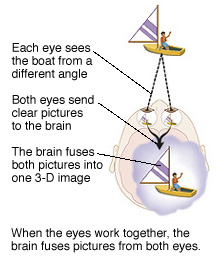Understanding Strabismus and Amblyopia
Understanding Amblyopia
Good vision takes a team effort from the eye muscles, eyes, and brain. When the eyes don't work together or one or both eyes have trouble focusing, the brain has trouble understanding what's being seen. This can cause vision problems.

How the eyes work together
Each eye sees from a slightly different angle. This means that two different pictures are sent to the brain. The brain blends these pictures into one 3D image.
When there's a problem
When the eyes don't work together, the brain receives pictures it can't blend together. The brain ignores (suppresses) signals it can't use. In most cases, signals from only one eye are ignored. The signals from the other eye are interpreted as a flat image instead of a 3D image. During suppression, normal vision can't develop in the eye that's being ignored. This is called amblyopia.
Alignment problems (strabismus). One eye looks in a different direction from what it's trying to see. This may happen all the time. Or it may happen some of the time.
Focusing problems. One or both eyes have trouble focusing. The brain receives blurry pictures. Focusing problems include:
-
Being nearsighted (distant objects look blurry)
-
Being farsighted (nearby objects look blurry)
-
Having astigmatism (both nearby and distant objects are distorted). In some cases, focusing problems are worse in one eye than in the other.
Other problems. In rare cases, sight in one or both eyes can be blocked. This can be caused by a problem such as a cloudy lens (cataract). An eye doctor can tell you more about this.
Updated:
January 23, 2020
Sources:
Amblyopia in children: Classification, screening, and evaluation. UpToDate.
Reviewed By:
Bogus, William J., OD, FAAO,Griggs, Paul B., MD